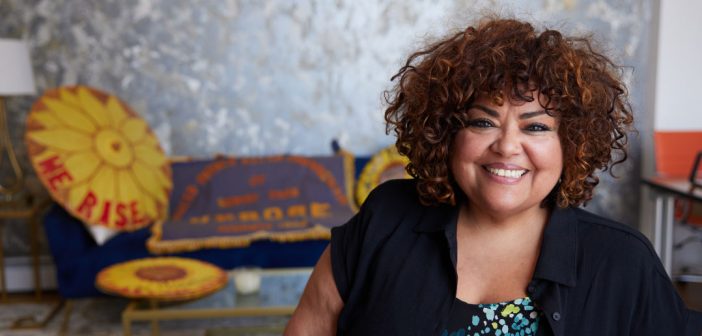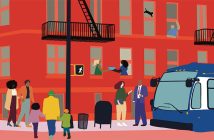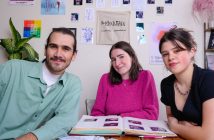“There’s a long history of young people challenging systems, dismantling systems, and manifesting a vision that has put us on a course to be a different kind of nation,” says Yeampierre, an attorney who co-chairs the national Climate Justice Alliance and is executive director of UPROSE, a Latino community organization based in Sunset Park, Brooklyn.
It’s a message of hope and empowerment she brought to her alma mater on April 19 as the keynote speaker at “Fordham in Community: A Summit on Community Power and Just Climate Actions.”
Born in New York City, Yeampierre moved with her family from Manhattan’s Upper West Side to Harlem, Washington Heights, and the Bronx before enrolling at Fordham, where she majored in political science. After graduation, she earned a law degree at Northeastern and embarked on a trailblazing career as an educational and environmental justice advocate—at the grassroots level and on a grand scale.
As executive director of UPROSE since the mid-1990s, she has helped to double the amount of open space in Sunset Park, facilitate participatory community planning, and organize young people of color for climate justice. She spoke at the White House’s Forum on Environmental Justice in 2010, helped lead the People’s Climate March in 2014, and served as the first Latina chair of the U.S. Environmental Protection Agency’s National Environmental Justice Advisory Council.
Across all her work, Yeampierre has pushed for community-led climate adaptation strategies and sustainable development—and underscored the links between racial injustice and climate change. She spoke with Fordham Magazine about her career journey and what she tells people who want to take action for environmental justice.
Why did you decide to attend Fordham?
I had visited a bunch of colleges—Barnard, Harvard. Fordham just felt like home. I remember walking into the Higher Education Opportunity Program office and seeing people who looked like me, who came from a working-class background. And I thought, “This is a place where I can do what I need to do.”
What was your introduction to climate justice work? Was it an area that you always felt drawn to and knew about?
Absolutely not. I thought that environmentalists were tree huggers who dressed poorly. I didn’t see the connection between the environment and my lived experience. My goal was to become a civil rights litigator. But I grew up in an environmental justice community. My family has all the health disparities that one would have living in the midst of toxic exposure, and so do I.
When I came to UPROSE, I was trying to figure out what we can do that complements what other people are doing and serves unmet needs. I realized that if you couldn’t breathe, you couldn’t fight for justice. So that was my entry into environmental justice work.
Prior to that, you worked for the Puerto Rican Legal Defense Fund, at the American Indian Law Alliance, and as a dean of student affairs at Yale. People might not necessarily think of these as environmental justice or climate justice jobs. But can you talk about the through lines between them and the work that you do now?
The environmental justice and climate justice movement is intersectional. Everything that you do—it doesn’t matter what you study, it doesn’t matter what field, what gives you joy—it’s going to be impacted by climate change. The environment is everything: where we live, where we pray, where we work. It’s everything for us.
At the Puerto Rican Legal Defense Fund, I was working to get students of color into law school, and I was trying to encourage them to use their education as descendants of the Civil Rights Movement to advance our civil and human rights.
Then at the American Indian Law Alliance, we were based in New York, and we were working with tribes and nations from all over. It was a space where all the traditions and all the practices were consistent with the tradition of honoring Mother Earth.
Then I go to Yale to be dean of Puerto Rican student affairs. It was a great opportunity to bring in community and to take the resources that Yale had to honor its host community.
I see that each of these were part of a path that was making it possible for me to understand how different institutions operate, what some of the challenges are for different groupings of people, all of whom come from struggle.
What kind of advice do you give young people about how to make a difference when it comes to environmental justice and climate issues? And how do you encourage them to avoid despair?
If you’re Black, Indigenous, or a person of color, you exist because the generations that came before us, who went through things that we can’t even imagine—who were in shackles, who were tormented, who were tortured, who were raped, who went through unimaginable violations of human rights—imagined us. They stood up and they fought. They built community, and they made it possible for us to be here. They went through existential threats.
Existential threats are not new to us, and we’re literally the descendants of people who walked in their power and transformed the experiences that they had and opened doors so that we could walk through them. To feel despair or to feel like we don’t have power is to dishonor our ancestors, because they went through things that we can only imagine.
The environmental justice movement is intergenerational. We believe that leadership is a continuum and that this country pits generations against each other. There is strength in that intergenerational power, and it doesn’t threaten anyone. There’s room for everyone to exercise leadership.
Across ages, when people say, “I care about this. I want to be, if not directly involved, an ally to the environmental justice and climate justice movements, but I don’t know what concrete steps to take,” what kind of advice do you offer?
A few things. One, I would say, read the Jemez Principles for Democratic Organizing so that you know how to come into the space to do the work necessary to be an ally. Do some mapping to find organizations that are doing this work and have a long history of doing it, and then call them and say, “How can I help? Do you need us to help you raise funds? Do you need us to help you with direct actions? Maybe it’s an art build. I have time. I’m available. How can I help support—not supplant, but support—the work that you are doing?”
If you go to the Climate Justice Alliance website, we have frameworks and guidelines for just about everything. They’re not coming out of one person’s head. They’re coming out of the collective, across the country, because this is an all-hands-on-deck moment. If you have passion, and if you really want to engage in this work, you have to then be part of building relationships and engaging in self-transformation.
As Earth Day comes up, you see a lot of organizations making pledges and starting sustainability initiatives. Sometimes we come to find out that it was “greenwashing,” and that those initiatives are offset by the negative impacts of the company’s actions. What can organizations do to truly make a positive impact and become allies in the climate justice movement?
That’s a hard question, but there are businesses that have been working hard to build those relationships. You’ve got Patagonia. Patagonia is an example of a business where, how they treat their workers, their products, the frameworks, the materials that they produce—they literally contact environmental justice organizations all over the country and they ask, “What do you think of this? How should this be shaped?” They have people who volunteer to support our events, our community gatherings, our direct actions.
We’re going to have to create different economies of scale, and we’re going to have to support small businesses that exist in our community. It’s really a matter of how much is enough for a corporation. At what point are you trying so hard to have more than you need—or doing so much that you’re harming the planet—that you are no longer a company that we want to support?
Right now, we’re experiencing what I call a green gold rush. People are seeing the green economy as an opportunity, and they’re coming at it as opportunists. It’s not going to look any different from the economy that got us to where we are, except that it’s going to have this green patina on it. We’re seeing that with offshore wind at the South Brooklyn Marine Terminal, where it can be a model of a just transition, but it is dangerously close to becoming an ecosystem that really models the bad behavior of some of the companies that are involved, like BP. So we have to monitor that really closely.
How can the public gain the literacy to know which organizations and initiatives truly support the climate justice movement?
It’s hard because you only have so much information, and people want to do the right thing. But I wouldn’t put the blame on the individual.
The truth is that in our community, particularly among Black and brown people, we live within our carbon footprint. I want to say that, because people are so desperate to engage and to participate and are so worried that they are not doing something that helps the planet. And media has given people the impression that they’re the problem. Those corporations, those fossil fuel companies, are the ones responsible.
I really want to make sure that even while people are making informed choices, they’re thinking about what fossil fuel companies are doing to destroy the planet.
We also have to hold the government accountable for giving some money to environmental justice but then funding offshore oil, supporting the Willow Project and other initiatives that harm our community. Or we have to blame big green organizations that say that they’re about the environment but are supporting green hydrogen, carbon sequestration, and other false solutions that turn our communities into sacrifice zones. Those are the folks that we really need to worry about.
It’s easy for our communities to think, “Okay, maybe I need to turn off the lights.” Turning off the lights is not enough. But you know what? Having a community on a solar array that creates community wealth—that’s a really cool thing. Getting off the grid, finding alternative options, and providing renewable energy, those are really cool things, and those are things that are on a different scale.
Interview conducted, condensed, and edited by Adam Kaufman, FCLC ’08.



